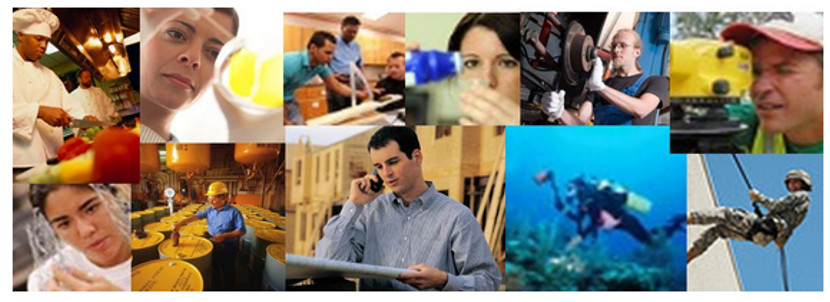What is Career and Technical Education?
The term "Career and Technical Education" is used to refer to a diverse range of educational activities designed to prepare students to gain entry-level employment in high skill, high wage, and high demand occupations or to continue their education in a chosen career field. Continue reading below to learn how Career and Technical Education is defined by the U.S. Department of Education.
Definition
Career and Technical Education is defined in the Carl D. Perkins Career and Technical Education Improvement Act of 2006 as organized educational activities that:
- Offer a sequence of courses that—
- provides individuals with coherent and rigorous content aligned with challenging academic standards and relevant technical knowledge and skills needed to prepare for further education and careers in current or emerging professions;
- provides technical skill proficiency, an industry-recognized credential, a certificate, or an associate degree; and
- may include prerequisite courses (other than a remedial course) that meet the requirements of this subparagraph: and
- include competency-based applied learning that contributes to the academic knowledge, higher-order reasoning and problem-solving skills, work attitudes, general employability skills, technical skills, and occupation-specific skills, and knowledge of all aspects of an industry, including entrepreneurship, of an individual.
Source: Carl D. Perkins Career and Technical Education Improvement Act of 2006, PL 109–270, Sec. 3. Definitions
You will learn more about the Carl D. Perkins Act later in Lesson 1.
|
|
What is the Purpose of CTE?
Career and Technical Education is a cornerstone of a national initiative to increase the competitiveness of the U.S. workforce in the global economy. It provides students with:
core academic skills and how to apply them to real-world situations in the workplace or daily life,
employability skills essential in any career,
job-specific, technical skills related to a specific career pathway.
Career and Technical Education gives students a foundation for career success by integrating rigorous academic content with job-specific technical skills and hands-on learning. Students who complete a CTE program of study in high school will be prepared to obtain an entry-level position or pursue more advanced education and training in their chosen career field.
The Carl D. Perkins Act challenges Career and Technical Education programs to prepare students for "high skill, high wage, and high demand occupations in current or emerging professions.
TEACHING TIP"Tell me, and I'll forget. Show me, and I may not remember. Involve me, and I'll understand." Native American Saying |
What is the Carl D. Perkins Act?
The Carl D. Perkins Career and Technical Education Improvement Act of 2006 is the current federal legislation governing Career and Technical Education programs in the United States. It was passed almost unanimously by Congress in late July 2006 as a means of raising the quality of technical education within the United States and enhancing the national economy. The Perkins Act, which extends through 2012, provides almost $1.3 billion in federal support for career and technical education programs in all 50 states.
The Perkins Act was first authorized in 1984 as the Carl D. Perkins Vocational and Technical Act. It was reauthorized in 1990 as the Carl D. Perkins Vocational and Applied Technology Education Act (Perkins II) and again in 1998 as the Carl D. Perkins Vocational and Technical Education Act (Perkins III). The renaming of the Perkins Act to the Carl D. Perkins Career and Technical Education Improvement Act (Perkins IV) represented a distinct philosophical shift with regards to preparing secondary students for the workplace.
A Solution to 21st Century Challenges
Since the beginning of the 21st century, the world has experienced increased globalization and rapid technological advances. To stay competitive, the United States needs a skilled workforce. In 2003, the U.S. Chamber of Commerce reported that employers were finding it harder and harder to find applicants for entry level positions requiring technical skills. At the same time, high school dropout rates were increasing. The Carl D. Perkins Act was amended and improved in 2006 as a means of addressing these 21st century challenges. The focus was no longer on "vocational" programs but on "career and technical education" instead.
What is the Difference between Vocational Education and CTE?
A vocation is defined as an occupation to which one is well suited, a trade, or a calling. A career is a general course or progression of one's work life, a chosen pursuit, profession, or occupation.
A precedent for separating academic and vocational instruction and funding was set by the first federal vocational education act, the Smith-Hughes Act of 1917. Its intent was to protect vocational funding for job-specific skills training. However, it resulted in the separation of vocational and academic students into separate "tracks." In the 1960s, Federal Vocational Education Acts began placing greater emphasis on providing assistance to disadvantaged individuals. The unintended consequence of this emphasis was that vocational education came to be viewed as a track for students who could not succeed in the academic track.
The Carl D. Perkins Career and Technical Education Improvement Act of 2006 was a direct response to the challenges posed by a new knowledge-based, global economy and a widening gap between well-paying jobs and unemployed, under-educated workers. The shift from "vocational education" to "career and technical education" moves the focus to preparing students for productive long-term careers.
To accomplish this, Career and Technical Education integrates academic and technical education into career pathways students can follow through high school into an entry-level job or postsecondary training and education. There are countless career pathways, so ideally, each student will work with his or her counselor to create an individual career pathway that will lead to a chosen career. Students will individualize their career pathways by selecting from courses and activities which are organized within "Career Clusters."
What are Career Clusters?
Career Clusters are groupings of occupations and industries. They provide a context for students to learn knowledge and skills specific to their chosen careers. Career Clusters also serve as an organizational tool to enable educators to structure the curriculum.
There are sixteen federally defined Career Clusters. Within each Career Cluster there are various Programs of Study, or career pathways. These Programs of Study are designed to guide students in selecting coursework and activities to achieve their career goals.
All of the Career Clusters include core academic skills plus employability skills essential to any career including:
- Communications
- Problem-solving and critical thinking
- Information technology systems
- Leadership and teamwork
- Ethics and legal responsibilities
- Safety, health, and environmental
- Employability and career development
Each Career Cluster also includes knowledge and skills specific to industries and occupations within the group.
Although each Career Cluster is somewhat specific, the organization and structure of each Career Cluster includes academic and technical knowledge and skills for a broad grouping of occupations and industries. This allows students participating in any given Career Cluster to pursue a wide range of career opportunities, from entry-level all the way through management and professional levels.
The following pages show the icons developed and adopted at the federal level to represent each of the clusters, along with a brief description of each cluster.
Career Clusters
Business Management and Administration careers encompass planning, organizing, directing and evaluating business functions essential to efficient and productive business operations. Business Management and Administration career opportunities are available in every sector of the economy.
Careers in Agriculture, Food and Natural Resources involve the production, processing, marketing,distribution, financing, and development of agricultural commodities and resources. These include food, fiber, wood products, natural resources, horticulture, and other plant and animal products or resources.
Architecture and Construction careers are involved in designing, planning, managing, building, and maintaining the built environment.
Arts, A/V Technology and Communications careers encompass the designing, producing, exhibiting, performing, writing, and publishing of multimedia content, including visual and performing arts and design, journalism, and entertainment services.
Education and Training careers include planning, managing, and providing education and training services, as well as related learning support services.
Finance careers revolve around planning and providing services in the areas of financial and investment planning, banking, insurance, and business financial management.
Government and Public Administration careers involve executing governmental functions in the realms of planning, management, governance, national security, foreign service, revenue and taxation, and regulation - at the local, state, and federal levels.
Health Science careers involve the planning, managing, and provision of therapeutic services, diagnostic services, health informatics, support services, and biotechnology research and development.
Hospitality and Tourism encompasses the management, marketing, and operations of restaurants and other food services, lodging, attractions, recreation events, and travel-related services.
Human Service careers prepare individuals for employment in career pathways that relate to families and human needs.
Information Technology careers build linkages within the framework of IT occupations for entry-level, technical, and professional careers related to the design, development, support, and management of hardware, software, multimedia, and systems integration services.
Careers in Law, Public Safety, and Corrections and Security revolve around planning, managing, and providing legal, public safety, protective services, and homeland security, including professional and technical support services.
Manufacturing careers encompass planning, managing, and performing the processing of materials into intermediate or final products, as well as related professional and technical support activities such as production planning and control, maintenance, and manufacturing or process engineering.
Careers in Marketing involve planning, managing, and performing marketing activities to reach organizational objectives.
Careers in Science, Technology, Engineering and Mathematics involve providing scientific research, professional and technical services, laboratory and testing services, and research and development in areas such as physical science, social science or engineering.
Careers in Transportation, Distribution and Logistics encompass planning, management, and movement of people, materials, and goods by road, pipeline, air, rail, and water. It also includes related professional and technical support services such as transportation infrastructure planning and management, logistics services, mobile equipment, and facility maintenance.








































